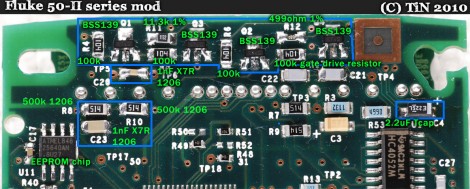
The difference between Fluke’s 54 II and 51 II thermometers is the addition of a second channel for dual temperature sensing, and buttons which control data logging. Oh, and an additional $150 in price for the higher model. [TiN] was poking around inside and with the help of some forum members he figured out how to unlock additional features on his low-end Fluke temperature meter. You can do the same if you don’t mind cracking open the meter, sourcing and soldering most of the components seen above, cutting holes in the case for the buttons, and hoping it still works when you put everything back together.
It seems that Fluke designed one full-featured unit and watered it down to fill a hole in the lower-priced market just like some other testing-hardware manufacturers (Rigol’s digital storage oscilloscopes come to mind). But the MSP430 P337I in this meter cannot be reflashed, so this would most likely be unhackable hardware if the firmware for the two models is different. After some intensive study of the PCB layout [TiN] found a set of resistors which seemed to serve no external hardware purpose. They do connect to the microcontroller and together they create a two-bit code. He was able to get pictures of the four different hardware models and work out which resistor combinations identify the different meters. Now he can get the firmware to believe it is operating a Fluke 54 II, the rest is just putting the correct passive components onto the unpopulated locations.
We think the quest is what is of interest with this hack. [TiN] did an amazing job of photographing and writing about each step in the process. We’re unlikely to try this ourselves but loved reading about it.















You’d be hard-pressed to find a manufacturer of any hardware that didn’t do this in some form.
Now THAT’S a hack. Thumbs and toes up.
Wonderful work. This stuff brings me to HaD.
very nice, too bad Fluke is soooooo expensive
Now I have to modify mine! This is great. You’d be surprised (or maybe not) at just how many manufacturers do this. Just remove a few parts (or don’t add them) or maybe a different code module and they have several “different” piecces of equipment.
For those that don’t know, it’s easier to design one fully functional device, and build it, minuse just a few parts. Keeps you (the manufacturer) from having to design two totally different devices.
Sad the costs differences are so great though.
I have a couple of Metrix multimeters that look like tricorders in terms of flip-open graphical LCD screen, they’re completely identical in external design for one-handed use but the MTX3283 is a bluetooth version and the MTX3282 isn’t.
Makes me wonder if the non-BT model has a spot where a BT module could be soldered, just like the old Asus Eee 900’s that could be upgraded with the right BT module and it would show up in the BIOS as default.
I hate companies that do this.
This is capitalism at his best.
Capitalism?! Perhaps it’s just good engineering design efficiency.